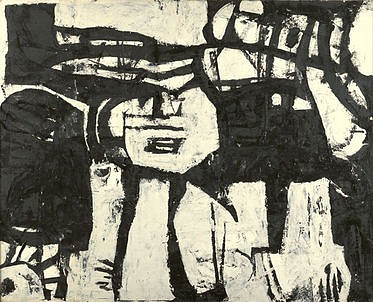
Overshadowed During her Lifetime, an Abstract Expressionist Gets her Due
February 29, 2016 - Bridget Gleeson for Artsy
In the Hamptons of the 1950s and ’60s, there were two significant pairs of artists working in Abstract Expressionism. The two couples were also friends. One set you know: Jackson Pollock and Lee Krasner. The other you might not: James Brooks (1906–1992) and Charlotte Park (1918–2010).
Brooks and Park were both artists when they met in Washington, D.C., during World War II. They moved to New York together in 1945 and forged a fast friendship with Pollock and Krasner, renting studio space from them in the city and eventually following their lead to resettle on Long Island. “These artists were forging a new aesthetic,” Helen Harrison of the Pollock-Krasner House and Study Center has said, “and only they understood what they were doing, so there was this sense of camaraderie.”
Of the four artists, it’s safe to say that Park, a graduate of the Yale School of Fine Arts, has received the least attention. She worked quietly for decades, her paintings overshadowed by her husband’s. It was only later, toward the end of her life, that art historians and critics noted her contributions to Abstract Expressionism. Now, her work is the subject of a new retrospective at Berry Campbell Gallery in New York.
Park’s work followed an interesting trajectory over the course of her long career. In the early years—the New York City years—she worked in monochrome, but by the mid-1950s, she was working in color and incorporating drawing into her paintings, their shapes defined by curving black lines with vibrant hues of orange, green, and blue. Though the colorful, textural pieces are abstract, they’re filled with vaguely familiar forms. Park, it must be noted, was an avid bird watcher and outdoor enthusiast; her observations of the natural world, recorded in her journals and sketchbooks, made their way into her formal work. In later years, Park went on to work in collage, ultimately paring down to more minimal compositions in the 1970s and ’80s.
Though she exhibited fairly widely in both New York and Long Island during her lifetime, she never earned as much attention as her more famous contemporaries; her legacy, it seems, has been recognized posthumously. Fortunately, just ahead of the artist’s death in 2010, Roberta Smith wrote a glowing tribute in the New York Times, calling Park “a natural painter and a gifted colorist” while noting her “ascension into the ranks of widely known Abstract Expressionists.” Such a review might have come too late for Park to fully appreciate, but luckily for the viewing public, the show at Berry Campbell is surely just one of several new opportunities to appreciate her work.
—Bridget Gleeson
Charlotte Park’s paintings are on view at Berry Campbell Gallery, New York, Feb. 11–Mar. 12, 2016.
Follow Berry Campbell Gallery on Artsy.
Back to News
